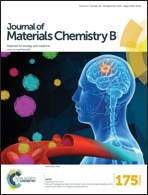Aggregation induced emission enhancement and growth of naphthalimide nanoribbons via J-aggregation: insight into disaggregation induced unfolding and detection of ferritin at the nanomolar level†
Abstract
A series of novel V-shaped naphthalimide derivatives are reported herein, designed through a strategy to achieve aggregation induced emission (AIE), giving rise to unexpected self-assembly properties. This includes an aggregation induced emission enhancement (AIEE) active small organic molecule viz. naphthalimide derivative functionalized with 8-hydroxyquinoline (α-NQ), that spontaneously forms highly fluorescent “nanoribbon” like structures with <100 nm diameter and hundreds of micron length in aqueous media irrespective of concentration and surface at room temperature. The classical head-to-tail π–π stacking, as revealed by the single crystal X-ray study, was found to be the main driving force for the J-type aggregation with unique self-aggregating behavior. A comparative mechanistic study confirms that the N-atom in the hydroxyquinoline moiety is responsible for directing the entire molecular behavior in solution as well as in its aggregated state. These α-NQ nanoribbons formed in aqueous media were found to be highly sensitive and selective towards the multi-functional nonheme protein ferritin (Ksv = 0.83 × 107 M−1) with a limit of detection 67.25 × 10−11 M (0.33 ng μL−1) under physiological conditions, which serves as a well-known inflammatory marker for various diseases. The fluorescent nanoribbons were also found to modify the α-helix content of ferritin, thereby inducing conformational changes in their secondary structure as confirmed through circular dichroism (CD) spectroscopy techniques. Collectively, these findings improve the fundamental understanding of the self-assembly of AIEE active molecules along with the photophysical properties of core substituted naphthalimide derivatives that report the highest sensitivity towards ferritin in the presence of a bright AIEEgen under physiological conditions.



 Please wait while we load your content...
Please wait while we load your content...